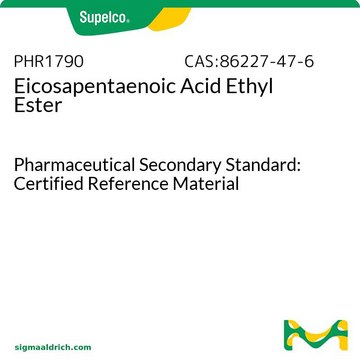T9900
Methyl tricosanoate
≥99.0% (GC)
Synonym(s):
Tricosanoic acid methyl ester
About This Item
Recommended Products
biological source
synthetic (organic)
Quality Level
Assay
≥99.0% (GC)
form
powder
technique(s)
gas chromatography (GC): suitable
color
white
mp
53-56 °C (lit.)
solubility
chloroform: 50 mg/mL, clear, colorless
application(s)
agriculture
general analytical
functional group
ester
lipid type
saturated FAs
shipped in
ambient
storage temp.
2-8°C
SMILES string
CCCCCCCCCCCCCCCCCCCCCCC(=O)OC
InChI
1S/C24H48O2/c1-3-4-5-6-7-8-9-10-11-12-13-14-15-16-17-18-19-20-21-22-23-24(25)26-2/h3-23H2,1-2H3
InChI key
VORKGRIRMPBCCZ-UHFFFAOYSA-N
Looking for similar products? Visit Product Comparison Guide
Related Categories
General description
Application
Features and Benefits
- High-quality molecule suitable for mulitple research applications
- Commonly employed in Metabolomics and Biochemical studies
Other Notes
Storage Class Code
11 - Combustible Solids
WGK
WGK 3
Flash Point(F)
235.4 °F - closed cup
Flash Point(C)
113.00 °C - closed cup
Certificates of Analysis (COA)
Search for Certificates of Analysis (COA) by entering the products Lot/Batch Number. Lot and Batch Numbers can be found on a product’s label following the words ‘Lot’ or ‘Batch’.
Already Own This Product?
Find documentation for the products that you have recently purchased in the Document Library.
Customers Also Viewed
Protocols
GC Analysis of a 37-Component FAME Mix on Omegawax® (15 m x 0.10 mm I.D., 0.10 μm), Fast GC Analysis
Our team of scientists has experience in all areas of research including Life Science, Material Science, Chemical Synthesis, Chromatography, Analytical and many others.
Contact Technical Service











